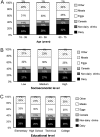100 YEARS OF VITAMIN D: Dietary intake and main food sources of vitamin D and calcium in Colombian urban adults
- PMID: 34766920
- PMCID: PMC8679881
- DOI: 10.1530/EC-21-0341
100 YEARS OF VITAMIN D: Dietary intake and main food sources of vitamin D and calcium in Colombian urban adults
Abstract
Data on dietary calcium and vitamin D intake from Latin America are scarce. We explored the main correlates and dietary sources of calcium and vitamin D in a probabilistic, population-based sample from Colombia. We studied 1554 participants aged 18-75 from five different geographical regions. Dietary intake was assessed by employing a 157-item semi-quantitative food frequency questionnaire and national and international food composition tables. Daily vitamin D intake decreased with increasing age, from 230 IU/day in the 18-39 age group to 184 IU/day in the 60-75 age group (P -trend < 0.001). Vitamin D intake was positively associated with socioeconomic status (SES) (196 IU/day in lowest vs 234 in highest SES, P-trend < 0.001), and with educational level (176 IU/day in lowest vs 226 in highest education level, P-trend < 0.001). Daily calcium intake also decreased with age, from 1376 mg/day in the 18-39 age group to 1120 mg/day in the 60-75 age group (P -trend < 0.001). Calcium intake was lowest among participants with only elementary education, but the absolute difference in calcium intake between extreme education categories was smaller than for vitamin D (1107 vs 1274 mg/day, P-trend = 0.023). Daily calcium intake did not correlate with SES (P -trend = 0.74). Eggs were the main source of overall vitamin D, albeit their contribution decreased with increasing age. Dairy products contributed at least 48% of dietary calcium in all subgroups, mostly from cheese-containing traditional foods. SES and education were the key correlates of vitamin D and calcium intake. These findings may contribute to shape public health interventions in Latin American countries.
Keywords: Latin America; calcium; dietary intake; nutritional epidemiology; vitamin D.
Figures




References
LinkOut - more resources
Full Text Sources
Medical
Research Materials

